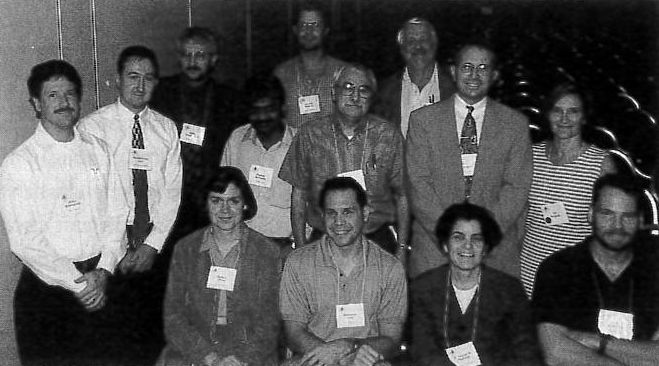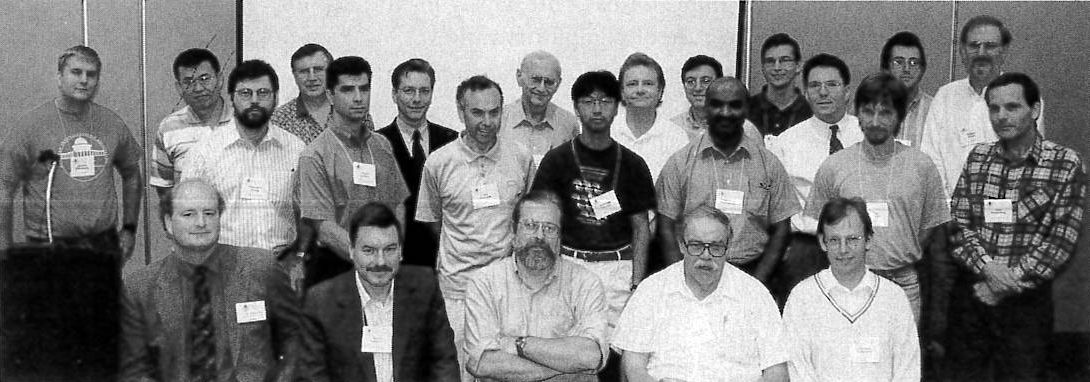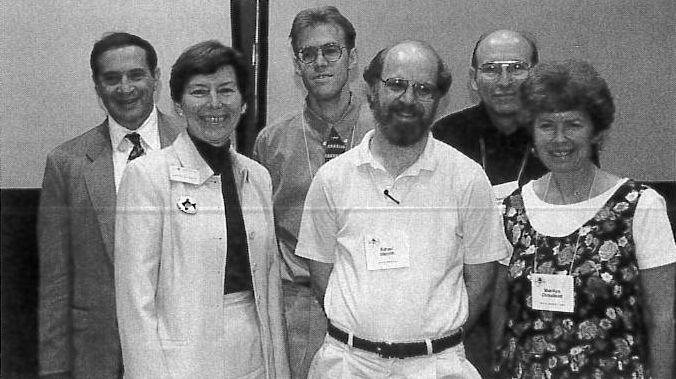ACA '98

Highlights of the 1998 meeting of the American Crystallographic Association (July 18-23, Arlington, Virginia) include the session marking the 50th anniversary of the IUCr, the transaction symposium on Crystal Engineering, a lively press conference, and a visit to the Hall of Geology, Gems and Minerals at the National Museum of Natural History.
Transactions Symposium: crystal engineering
Crystal Engineering is a cross-disciplinary field that concerns the development of protocols for predicting and controlling the structure and functional properties of solids. Such properties include color and melting point, polarity, porosity and conductivity and are relevant to areas as diverse as nonlinear optics, high Tc superconductors and polymorphism in pharmaceuticals. The session on Analysis, Prediction and Crystal Growth included talks on graph set notation in hydrogen bonded systems (R. Davis), prediction of entire crystal structures (S. Price), imaging crystals during growth using atomic force microscopy and self-assembly of higher density materials using organic/inorganic interfaces (T. Palmore). A session on Applications of Crystal Engineering described formation of inorganic coordination polymers as ion exchange or absorptive materials (R. Rogers), inorganic ion exchange in nuclear waste clean-up (A. Clearfield), the solid state reactivity of tailored stereoselective materials (B. Foxman) and a supermolecular synthon (K. Birdha). Hybrid Structures described organic/inorganic synthons with charge assisted hydrogen bonding and metal ion coordination (C. Aakeroy), nicotinamide lamellar organic sheets separated by rigid pillars with Ag(I) coordination, ligand coordinated polymers stabilized by large inorganic anions (J. Zubieta), the use of aggregates rather than molecules as building blocks (J. MacDonald), and multicomponents architectures (L. McGillavary). Discriptions of Weak Interactions included many that were stronger than conventional hydrogen bonds, including donor/acceptor bonding combined with CH-O hydrogen bonding in heterocyclic N-oxides (S. Blackstock), N-I interactions forming extended chains, dimers, or simple adducts (B. Pennington), and the six-fold phenyl embrace ubiquitous in the CSD and quite capable of directing overall structure (T. Steiner). G. Desiraju challenged the audience to devise new methods to compare, analyze and codify structures. He warned that unless such methods are developed, we will simply drown in a sea of crystal structures. The symposium was organized by R. Rogers (U. of Alabama) and M. Zaworotko (U. of Winnipeg). The Transaction Proceedings will be published in the Spring of 1999.
R. Rogers
Small angle scattering from complex materials
 Lecturers and participants in the workshop and symposium on Small Angle Scattering.
Lecturers and participants in the workshop and symposium on Small Angle Scattering.
Small-angle scattering of neutrons and X-rays can help integrate structural data from other methods (high resolution crystallographic, NMR, electron microscopy, etc) to the study of complex materials. The use of small-angle scattering techniques is driven by advances in chemical synthesis, deuterium labeling, computational power, algorithm development and modeling capabilities. Applications described included studies of the regulation of kinase activity (J. Zhao and J. Trewhella), proteins that aid in protein folding (R. May), ab initio protein folding, protein compaction and changes in hydration (S. Doniach), prion association implicated in neurodegenerative diseases (S. Doniach), aggregation of b-amyloid peptides linked to Alzheimer's disease (T. Thiyagaran) and the hydrothermal synthesis of zeolite NaA (S. Han). New developments in micro-synchrotron beams and lithographically fabricated mixing cells currently are being explored at CHESS and Princeton. A session on modeling small-angle scattering data addressed biological structures, materials and dislocations. Speakers described a suite of programs for biological structures and polydisperse systems (D. Svergun, svergun@embl-hamburg.de), analysis of membrane mimetic, self-assembled lipid layers and Langmuir-Blodgett films using reflectivity data (N. Berk), Monte Carlo simulation of micellar and polymer systems (J. Skov Pedersen), reverse Monte Carlo algorithms to model glass structure (J. Zwanziger), randomly oriented non-crystalline systems of interacting scatterers with structure on length scales from 10-20,000 Å (P. Schmidt), multiple small-angle neutron scattering from plasma-sprayed ceramic deposit microstructures with correlation to electron microscope images (A. Allen), and ultra-small-angle X-ray scattering by dislocation in single-crystal aluminum as a function of plastic deformation (G. Long). Small-angle scattering is ideal for monitoring conformational transitions and dynamic processes in non-crystalline states. Neutron contrast variation, and more sophisticated sample environments continue to expand the potential for materials research with these tools.
J. Trewhella
 A Poster Preview at the ACA meeting featured five minute presentations by young crystallographers in all areas of diffraction analysis.
A Poster Preview at the ACA meeting featured five minute presentations by young crystallographers in all areas of diffraction analysis.
Electronic materials
The session on Electronic Materials, organized by D. Cox and W. Wong-Ng, highlighted state-of-the-art X-ray and neutron diffraction studies of materials having useful electric and magnetic properties. Presentations included studies of the variation in the Tc of HgBa2CuO4+d (E. Antipov, Moscow), complex phase diagrams of mixed metal oxides (D.J. Buttrey, Delaware), magnetic ordering (G. Bottger), bond valence calculations for metal oxides (T. Santoro, NIST); magnetic phase transitions in systems with colossal magnetoresistance (P. Woodward, New York), ferromagnetic ordering in layered Mn(ReO4)2 where hydrogen bonding paths between layers play a role in the ordering (C. Torardi, DuPont), crystal engineering based on heterocycle radicals (W. Cordes, Arkansas), promising candidates for the next generation of hard magnets (H.Luo, Missouri-Columbia), and ternary BaO:TiO2:Fe2O3 phases having structural features corresponding to natural magnetic multilayers (L.A. Bendersky, Maryland). B. Sales (Tennessee) discussed filled skutterudites (LnFe3CoSb12) in which a "rattling" lanthanide atom results in low thermal conductivity. Other topics were a space charge model explaining the perovskite relaxor ferroelectrics (P. Davies, Pennsylvania), electrochemical expansion and contraction of AB5-type alloys and design of lower-cost non-Co alloys for use in nickel-metal-hydride batteries (T. Vogt, New York), experiments to determine the polarization charge density in GaAs requiring repeated measurement of several thousand intensities to obtain adequate statistics (U. Pietsch, Postdam), and characterization of three new high-temperature polymorphs of potassium dihydrogen phosphate determined by studying single-crystal islands within polycrystalline fragments. (A. Subramony, Washington).
J. Kaduk
Computational methods
 Computational Methods Speakers, front row, left to right: Julie Wilson, I. Uson, S. Sheriff, B. Yu, back row, A. Brunger, A. Perrakis, D. Turk, G. Bricogne, Eric de La Fortelle, Z. Dauter and D. Broderson.
Computational Methods Speakers, front row, left to right: Julie Wilson, I. Uson, S. Sheriff, B. Yu, back row, A. Brunger, A. Perrakis, D. Turk, G. Bricogne, Eric de La Fortelle, Z. Dauter and D. Broderson.
The Computational Methods session focused on user-friendly computational tools to better determine, visualize, and understand macromolecular structures. The wide range of topics covered included direct methods (I. Uson, Gottingen) density modification (G. Perrakis, EMBL Grenoble), structure completion (G. Bricogne, MRC-LMB Cambridge), six-dimensional Molecular Replacement (S. Sheriff, BMS; C. Kissinger, Agouron Pharm.), and 'Multi-MAD' strategies (A. Brunger, Yale). Small signals are increasingly used to learn more about the behavior of proteins at very high resolution (D. Brodersen, Aarhus) and very low resolution (B. Yu, Tallahassee). The anomalous signal of sulfur atoms at only ONE wavelength (SAD method) has even been used to solve a structure ab initio by classical heavy-atom phasing (Z. Dauter, Brookhaven) with direct methods being used only to detect the position of the anomalous scatterers!
E. de La Fortelle
Direct phasing of macromolecules
With respect to Direct Phasing of Macromolecules, structures containing as many as 2,000 non-hydrogen atoms are being solved routinely by Shake-and -Bake and SHELX "half baked" methods by Hauptman, Sheldrick, Weeks and Schafer. Gilmore described results from the maximum entropy-likelihood method focused on expanding the viability of the direct methods to lower resolution data. Direct methods procedures have proven to be extremely useful in tackling large proteins with substructures containing as many as 30 Se atoms (Smith and Howell). Low resolution data studies included the application of the Few Atoms Model (FAM) to the 50S Ribosomal Particles (Podjarny), using "glob" scattering factors with projected electron diffraction data (Dorset), and a procedure based on the genetic algorithm paradigm (Miller) for icosahedral viruses.
S. Fortier
Structure-based drug design
H. Einspahr (New Jersey), chairman of the symposium on Structure Based Drug Design, noted that structural information impacts the drug-design process at the lead-finding and lead optimization phases. Speakers discussed the design of inhibitors of tropical disease targets, cholera toxin and glyceraldehyde-3-phosphate dehydrogenase (W. Hol, Washington), HIV-1 protease inhibitors that combine potency, solubility, oral bioavailability, serum lifetime and safety (P. Fitzgerald, New Jersey), influenza virus neuraminidase inhibitors with nanomolar potencies (M. Luo, Alabama), dipeptide mimetics that preserved the essential backbone structure of a compound while disguising it from proteases (A. Swain, New Jersey), and ribosome-inhibiting proteins including ricin, shiga toxin and versatile pterin compounds (J. Robertus, Texas). Other protease targets described included Ras farnesyl transferase (C. Strickland, UK), integrase (J. Alexandratos, Maryland), and aldose and aldehyde reductases associated with the complications of diabetes (O. El-Kabbani, Australia). S. Abdel-Meguid (Pennsylvania) emphasized the importance to structure base drug design of experience, synthetic accessibility, water molecules, solubility of ligands, electrostatics, iterative design, maximizing interactions, starting the design from liganded structures and having dedicated molecular biology and protein purification teams.
H. Einspahr
Amorphous materials
Amorphous Materials pose a challenge to structural characterization techniques. A workshop on the topic concerned numerical modeling of disordered materials based on diffraction data and reliable representations of atomic interactions. P.H. Gaskell (UK) demonstrated how chemical bonding constraints can be used to help interpret low-Q diffraction data. R. McGreevy (Sweden) presented his reverse Monte Carlo method and D. Drabold (Ohio) and P. Vashishta (Louisiana) illustrated atomic scale simulation methods combining first-principle electronic orbital calculations with multi-million atom dynamic simulations to uncover extended-range structural characteristics. The full program included a Symposium on Non Oxide Gases (organized by J. Zwanziger, Indiana), Surfaces, Interfaces and Films (organized by W. Dmowski, Pennsylvania) and Colloids and Gels (organized by J. Kieffer, Illinois). The symposium on surfaces focused on the characterization of structural disorder in narrow interfacial regions and applications of state-of-the-art techniques ranging from small-angle and synchrotron X-ray scattering, to neutron reflection. B. Aiken (New York) illustrated potential photonic applications of some non-oxide glasses and R. Bush (California) described recently discovered five component bulk metallic glasses that remain amorphous and have outstanding mechanical properties without requiring the extreme quench rates typically associated with metallic glasses.
J. Kieffer Students and friends of Ken Trueblood gathered for a memorial session in his honor at the 1998 ACA meeting in Washington, D.C.
Students and friends of Ken Trueblood gathered for a memorial session in his honor at the 1998 ACA meeting in Washington, D.C.
Neutron scattering in structural biology
In a symposium on Neutron Scattering in Structural Biology, organized by B. Schoenborn and B. Von Dreele (New Mexico), speakers described locating solvent and hydrogen positions in crystals of tetragonal lysozyme (N. Niimura, Japan), concanavalin A (J. Helliwell, UK) and coenzyme cob (II)alamin (P. Langan, France). LADI uses a cold quasi-Laue beam in combination with a large neutron image plate (IP) detector to improve data collection efficiently. Comparisons of neutron and X-ray scattering density maps of myoglobin show that hydrogen can be located in atomic resolution X-ray maps. P. Langan described the structural biology station at LANL. With spallation neutrons and their time-dependent wavelength structure, diffraction data are collected as wavelength resolved spectra. B. VonDreele uses neutron powder diffraction to screen heavy atom derivatives and follow changes in protein conformation and packing. Other speakers discussed the use of low resolution (~12Å) neutron diffraction to locate detergent in crystal forms of porins (P. Timmins, France), phasing using a buried reference layer (C. Majkrzak, Maryland) and supermirror coated guides to maximize neutron flux (D. Clemens, Switzerland). Improvements in fiber data collection technology were described for studies of the coat protein of filamentous bacteriophage M13 (M. Ivanova, Florida), and DNA hydration using data collected with a large array of microstrip detectors was described (T. Forsyth, UK). The closing round table session chaired by J. Sacchettini (Texas), G. Bunick (Tennessee) and P. Langan addressed coordination of software development for new instruments, advantages of medium resolution neutron studies over high-resolution X-ray studies for locating hydrogen and the need for larger crystals and perdeuterated proteins.
P. LanganWays of thinking about structures
In the General Interest Group Session, Ways of Thinking about Structures, M. Spackman (Australia) described a new way of defining boundary surfaces around molecules in a crystal structure. Y. Abramov (New York) reported experimental and theoretical studies of the charge density in crystal structures of four D,L amino acids, emphasizing the bond critical points for the hydrogen bonds, and E. Bruton( Missouri) described a Cambridge Structural Database search for hydrogen bonds of the type D-HX-M in (M, a transition metal; X,F,Cl or Br; and D,C,N or O). Bruton's results are consistent with an electrostatic theory for hydrogen bonding. W. Ojala (Minnesota) presented a class of benzylidineanilines with a nitrile at one end and a halogen at the other that are acutely sensitive to the switching of the two substituents. Other topics included highly complex tiling patterns in the crystal structures of aluminum rich intermetallic compounds that contain pentagons which share edges connected by quadrilaterals and triangles (E. Ryba, Pennsylvania), a new way to look at familiar space group diagrams(C. Johnson, Tennessee), and the modelling of molecular features observed on the (110) face of a lysozyme crystal using an atomic force microscope (J. Konnert, Washington, D.C.).
Carol Brock
Publication and presentation of crystallographic results
 Speakers on techniques for data publication and presentation.
Speakers on techniques for data publication and presentation.
A session on Publication and Presentation of Crystallographic Results focused on tools, techniques, and philosophy. K. Duffy of ACS Journals discussed preparation of graphics for publication (http://www.pubs.acs.org/instruct/illus.html). The key advice is to use high quality originals directly from a laser printer and make the original 3.25 inches wide in order to identify potential surprises when reduced. G. Petsko spoke on the craft of lecturing and advised 1) Tell a story; 2) Tell only one story, 3) Tell the audience what you're going to tell them, tell them, and tell them what you told them; 4) Give a maximum of 24-33% background material; 5) Vary the pace of the talk, use no more than 1 slide/minute and at least 1 slide/2 minutes; 6) Be sure that all your slides/overheads can be clearly seen from the back of a large room that is not very dark so that you can still make eye contact with your audience. The minimum font size is 28 point, bold or even extra bold; 7) For complex subjects, try to find the right metaphor; 8) Be yourself, and use humor only if it's natural to you; 9) Don't read your slides, summarize them in different words; 10) Be gracious, give lots of credit; 11) Use colorful language and try to blend in analogies with every day life; 12) Don't use gimmicks like two projectors that might get in the way of clarity.
M. Olmstead
Conclusion
Over 1,100 crystallographers attended to hear 225 oral presentations, view the 350 posters and visit the exhibition where over 20 industrial companies displayed the latest in equipment, apparatus, books, software and services. Reporters and science writers attending a press conference heard presentations of highlights of the meeting. Subsequent media coverage included editorials highlighting the macromolecular program in Science and Nature Structural Biology and commentary in Physics Today. The banquet featured a presentation of the Elizabeth Wood Writing Award for 1998 to Robert Hazen. A full report of the oral presentations appeared in the Fall 1998 issue of the ACA Newsletter and can be viewed at http://www.hwi.buffalo.edu/ACA. The Local Chair was W. Wong-Ng and the Program Chair Louis Delbaere.


![[Crystallography Around The World] [Worldlogo]](https://www.iucr.org/__data/assets/image/0005/149540/world_bw.png)